Illuminating the Boss: Bruce Springsteen & the E Street Band Return to the Stage
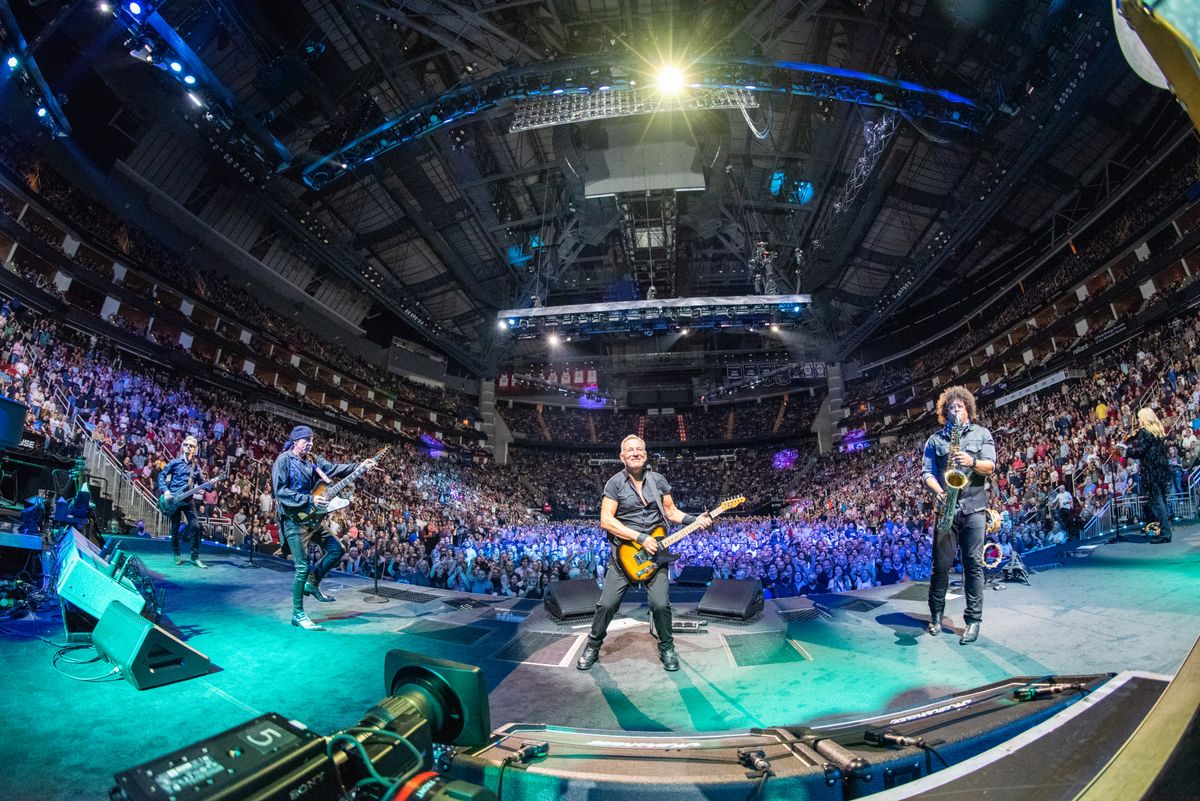
By Matt Bauer
All photos by Rob DeMartin
One of rock ‘n’ roll’s true living legends, Bruce Springsteen & the E Street Band, kicked off their 2023 World Tour February 1 in Tampa, Florida. The 2023 tour marks the first time since 2017 that Springsteen & the E Street Band have toured together. With the Boss since his landmark “Born in the USA” tour in 1984/85 is Emmy-winning lighting designer, lecturer, author, and long-time collaborator Jeff Ravitz.
Having designed numerous TV specials for awards shows, music-based programs, stand-up comedy, fashion, ice shows, debates, and interviews, as well as game shows, talk shows, and specialty scenes for feature films, Ravitz has been the broadcast lighting advisor to the Coachella and Lollapalooza festivals, while also designing the lighting of concert tours for artists as diverse as Ringo Starr, Cher, Steely Dan, Yes, and Styx, among many others. A highlight of Ravitz’s long and illustrious career was being named a Parnelli Lighting Designer of the Year. His design firm, Intensity Advisors, is based in Los Angeles.
“Lighting was a wonderful mystery to me at an early age, but I didn’t realize it was a career option until I went to college,” explains Ravitz, who co-authored the recently released book Lighting for Televised Live Events. “As a boy, I would see Broadway shows and all the fixtures pointing in every direction looked like chaos. But on the stage, it all converged to make perfect visual sense. So, at university, I took classes in lighting, directing, acting, and script analysis. Somehow, I kept coming back to lighting as something intriguing and powerful, and after a couple of school breaks working summer stock under talented lighting designers, I started to feel the tug.”
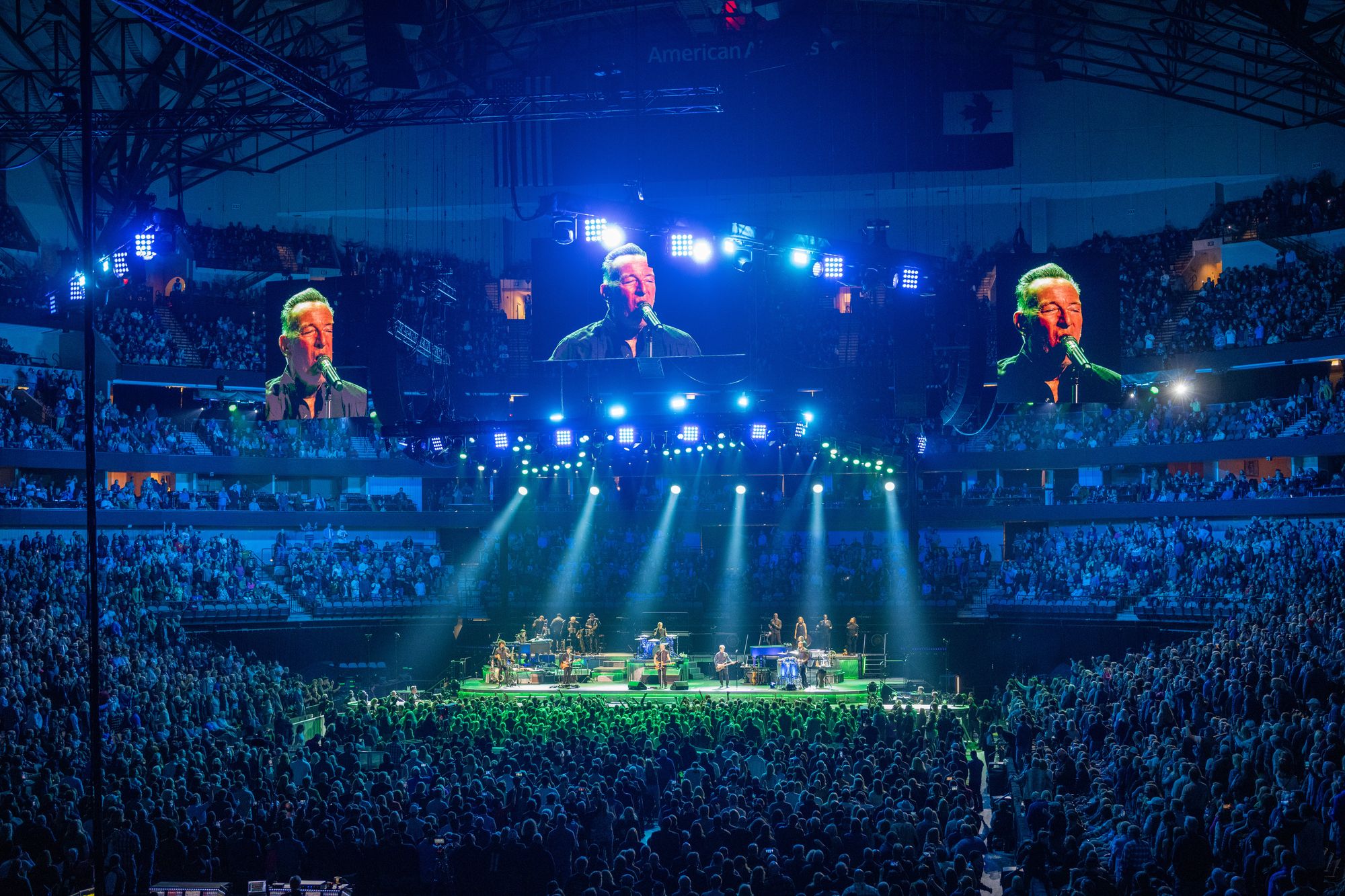
While Ravitz says that he was taught that lighting in theatre shouldn’t be noticed—it was considered a background element—a performance by the Grateful Dead opened his eyes. “It was very in-your-face—bold colours, haze with beams, snappy cues to the music,” he remembers. “That started the gears in my head turning, and amazingly, a week later, I saw an ad in a local arts journal placed by a band looking for an LD. I got the job, and working with twenty lights in nightclubs, I fell deeply in love with what I was doing.”
Ravitz notes that the diversity of his career has always been its most exciting part. “Sometimes I think about how I was doing Springsteen one year—a glorified bar band with few frills—and the next year doing a Cher show with dancers and over-the-top costumes, which was the other end of the spectrum. But even though I may design with a (more or less) recognizable style, I do not have a formula. To make each show look right for that artist, I learned to take my hand off the wheel for a moment, and let the show take me to the design solution. Each of those acts I designed is so unique, and requires a custom approach. I listen to the music, watch the performance style, talk to the artists or their representatives, and then let it all process in my brain until it begins to take shape. Yes, the music is often 4/4 timing (not Steely Dan or Yes!) but that’s where the similarities end!”
With lighting for Springsteen’s current jaunt supplied by Christie Lites, Ravitz used a wide variety of fixtures from several manufacturers. “It took a lot of time to finalize the equipment list,” he explains. “I researched and sampled every light. But these days the top manufacturers all make such excellent equipment. It was a crazy back-and-forth duel in my mind to pick one over another. And, I’m a Libra…so I was being true to my stars.”
His search started with the need for IP65-rated fixtures. “I knew the show was moving outdoors and I wanted to plan for that even though we didn’t need that capability for the arena shows played at the start of the tour,” he says. “The Elation Proteus line was appealing because I knew we would be subjected to lots of rain during the stadium tour. And the fact that they’re terrific lights didn’t hurt!” Ravitz says this is his first use of Proteus lights in an outdoor setting, although he has used them indoors on a couple of TV shows.
The lighting over the stage consists of three primary trusses—upstage, mid-stage, downstage—plus a front truss further downstage and a follow spot truss that hangs about thirty feet from the mic line. There are also side trusses right and left. For the arena shows, four trusses, each at a 45-degree angle to the room, hang from the four corners of the venue.
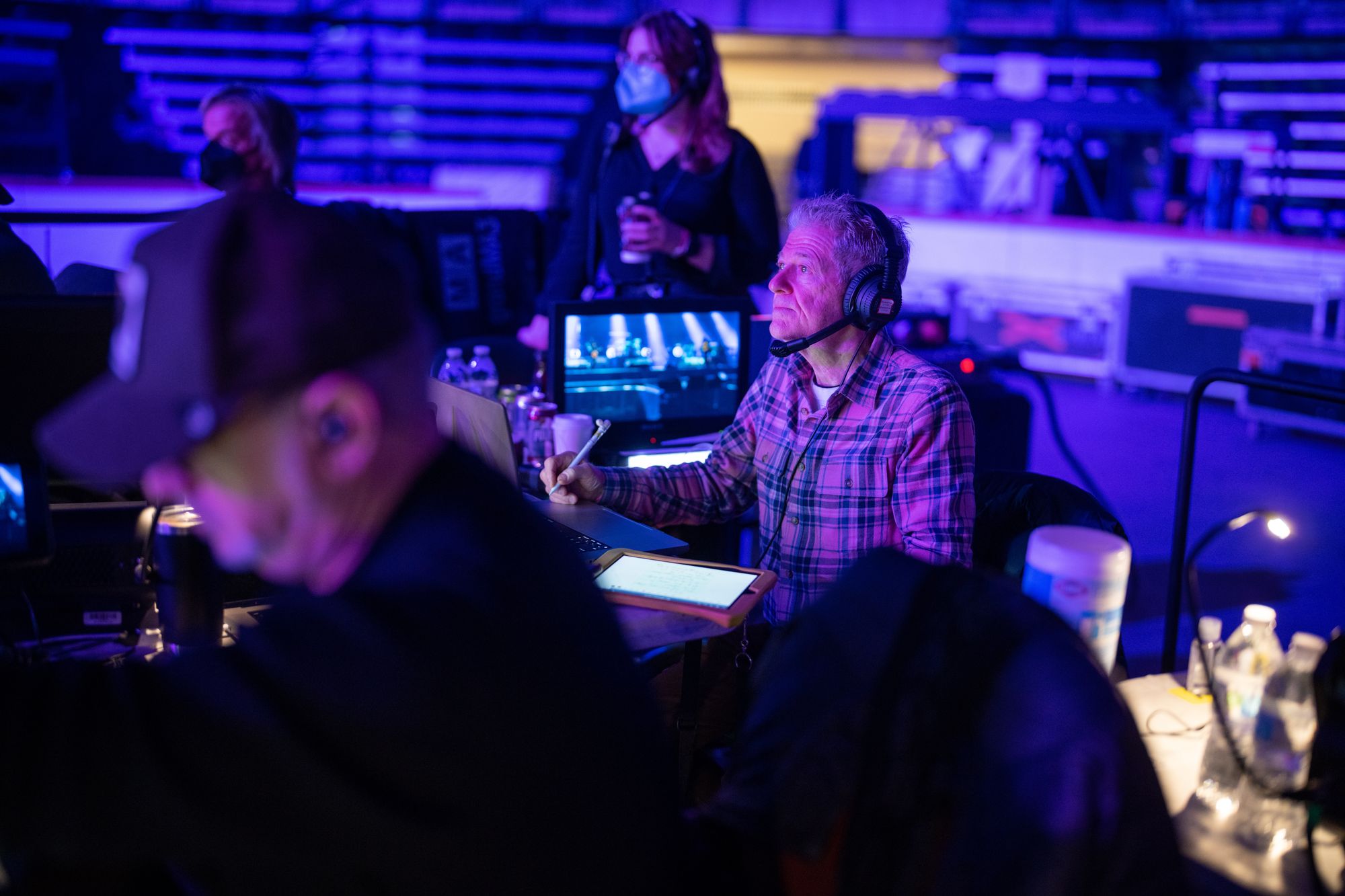
Ravitz has the Proteus Rayzor 1960s with their 19 x 60W RGBW LEDs trimmed high over the audience on the four corner trusses. “They are used to duplicate and extend our over-stage washes to the farthest reaches of the building—to stretch the look of the stage and lighting to the walls,” he says. “I like the 1960s because of their larger size—a good look for high trims and stadiums—substantial output, and good color. A bit less of a priority for this specific show, but still important were the effects it can do, both with individual LED pixel control and the SparkLED.”
The Proteus Rayzor 1960 is an 18,000-lumen big brother of Elation’s popular Proteus Rayzor 760. It can zoom tight or spread wide for even stage coverage, and designers can use its individual pixel control to create a variety of aesthetically unique eye candy looks. Like the Proteus Rayzor 760, it houses Elation’s exclusive SparkLED technology, a background sparkle look used for mood generation and an additional layer of effect.
Since the show is sold in a 360-degree configuration, there is audience everywhere — front, behind and to the sides of the stage. Ravitz comments, “To highlight them and bring the entire crowd into the performance space, we have Cuepix 16 IPs on every truss that has a clean shot to the audience: back, sides, front and the four corner trusses. That gives us a lot of coverage.” He says he landed on the Cuepix 16 IP after an exhaustive search for the right audience light for the show. “Their smooth field, clean look, good color and fun pixel effects convinced me.”
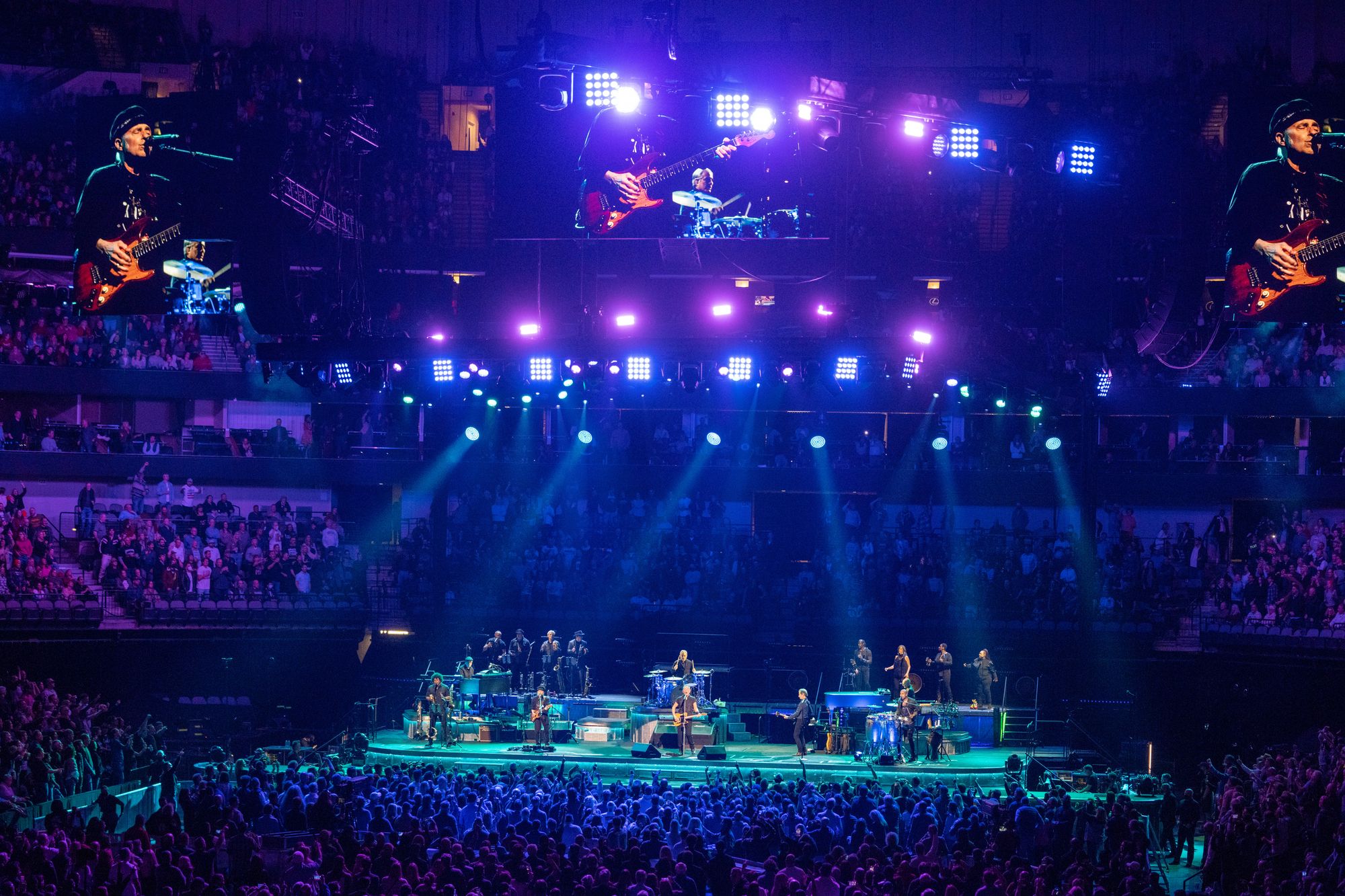
Working side-by-side with the Elation Cuepix IP16 audience blinder is Chauvet’s excellent motorized strobe/wash, the ColorStrike M. This powerful light gives a full color range that also allows for pixel effects, plus a super bright strobe bar across the center of the face.
Eight Proteus Hybrids on the floor, offstage—four per side—are used to provide accents and strong beamage and air graphics from a normally dark corner of the stage area. “This, like the 1960s, also widens the appearance of the stage,” he says. “The Proteus Hybrids are true beasts with enough output to cut through any amount of ambient light, even if gobo’d, or in deep color.”
Finally, four Smarty Hybrids work from on the offstage corners of the far downstage runway, which is a full cross-stage run that drops down one foot below the main stage. Ravitz remarks that he needed a smaller light to work in harmony with the Proteus Hybrids to do air fans and moves, “but not be a big, bulky fixture.”
The European leg, which kicked off on April 28 in Barcelona, marked the start of the outdoor stadium tour and according to Ravitz the show grows substantially. The European package mirrors the North American, plus the addition of several more Proteus Hybrids, Rayzor 1960s, ColorStrike Ms, and Cuepixes, and the introduction of the Proteus Rayzor 760s to the setup.
For the stadium setup, a bigger downstage runway extends right and left even further than for the arena show, going all the way to the side edges of the field. Out on those runways to the right and left of the stage, are enormous video screens. Ravitz explains, “For that setup there are more Proteus Hybrids under the screens on the deck, aiming up in the air, plus the 1960s that were on the corner trusses indoors move down to that same deck-level area, to make a really powerful line of washes and spots. Finally, there are more 1960s way out in the house on the follow spot/audio delay towers.”
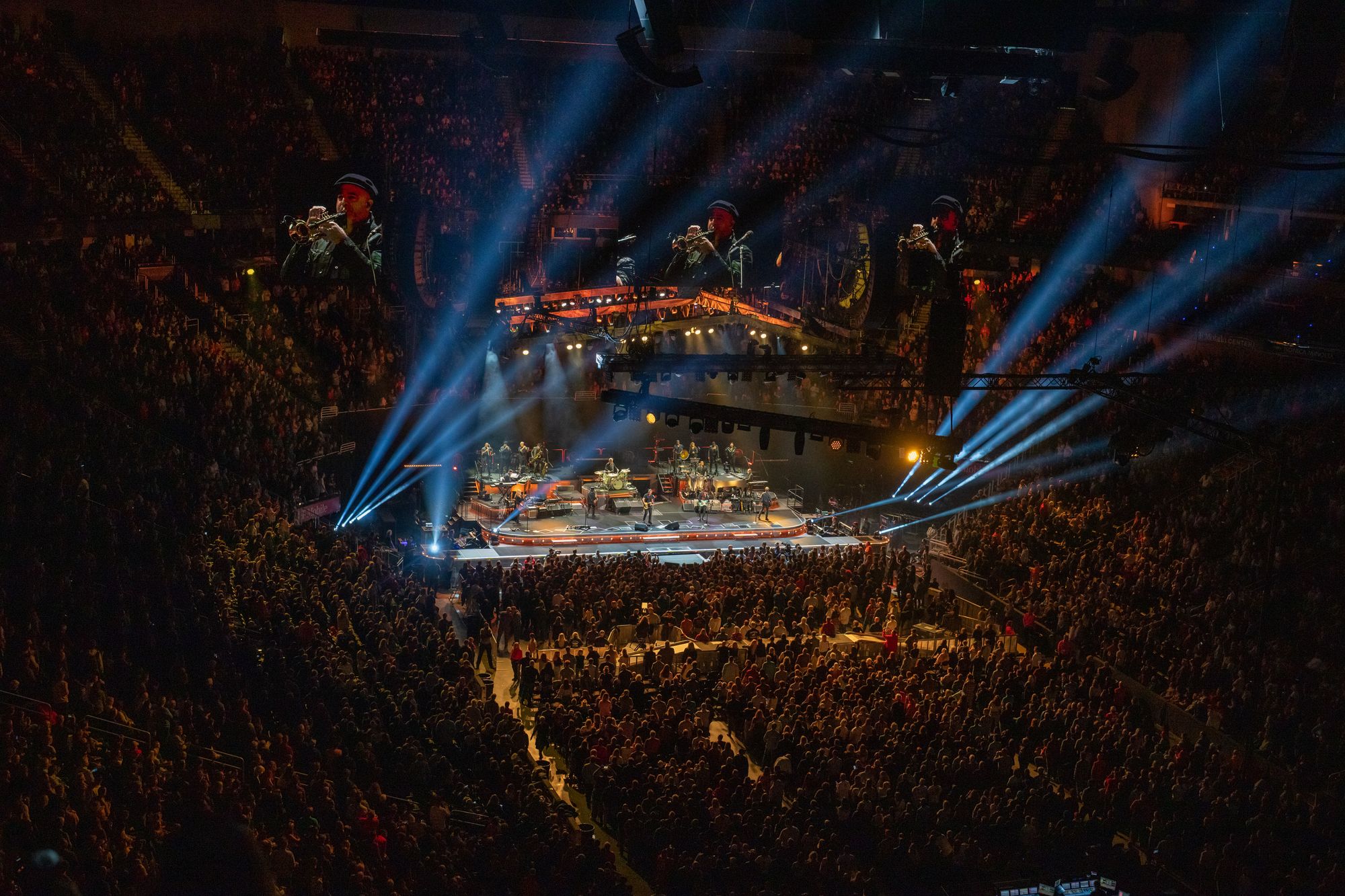
The Proteus Rayzor 760s will be a new element for the stadium setup, and will be on the deck in a line across the centre of the stage at the very bottom of the lower downstage runway. “They will add a powerful outline of lights to that section, to match and extend what the 1960s are doing offstage right and left,” the designer says. “I chose the 760s because they fit better into the narrow space available in that area. In previs, the entire combination of 1960s and 760s is looking amazing.”
Ravitz says the SparkLED effect in the Proteus Rayzor 760 and 1960 is in the plans for the stadium show, where the lights will be very close to the audience and directly behind Bruce when he works the lower offstage runway. He says they’ve been playing with the effect in the stadium show previs and are excited about its potential.
To surround the crowd with even more sparkle and color, Ravitz added Astera’s AX10 wireless, battery-powered PAR spaced out around the entire venue. “Initially, I was concerned it would be impractical, but it sets up relatively simply (easy for me to say!), clamped to the concourse handrails,” he says. “We had to play with the wireless signal a bit since the distances can be far, but our crew chief, Hadyn Williams, along with our Christie Lites tech coordinator, Russell Benoit, did some technical magic and got it sorted out.”
“We used to have quite a few Sharpy spots hidden behind the facia of the three-foot high upstage level. It was a great effect—somewhat impractical to set up— and I was looking for an alternate approach. I’m using GLP’s fabulous FR10 motorized striplight, turned vertical and spaced out across the front of this same three-foot cross-stage upper level. With ten lensed cells that can zoom tight or wide, we can get very visible beamage or a more subtle array of colored sources.”
The newest type of light introduced for the Stadium set-up is the Clay Paky Xtylos Aqua, a compact laser-sourced fixture that kicks out a powerful beam, tight or wide, gobo’d or open. It’s used for accents and punctuation cues, and air graphics. Like most of the gear, it is IP-65 to survive the outdoor shows.
With an extensive catalogue of songs and even more added, Ravitz admits that he was up against time constraints to cue the show, which was compounded by the E Street Band’s seven year gap since their previous outing. “Our tours generally are promoting a new record release but this time there were three new albums,” he says. “We got a list of music to prepare, but the list kept growing. And my experience with this artist has taught me to be ready for a lot more.
“We had a longer rehearsal period than ever before,” he continues, “which helped a lot, but with all the new gear to integrate into the cuing, and all the new material to prepare, we all wished we had even more time. Thankfully, my magnificent FOH team consisting of tour LD, Todd Ricci, programmer, Mike Appel, console #2 operator, Brad Brown, design assistant, Violet Smith, and longtime backup operator, John Hoffman, all pitched in with their A+ game. It’s a methodical approach, beginning with the new material, and then working through the older numbers, cleaning up any outdated looks, and adding the new elements.”
With the 2023 tour concluding December 10, in San Francisco, Ravitz reflects on his relationship with Springsteen: “Most of his concerts present a mix of music from all phases of his career and catalogue. So a neutral approach was clearly the best—a truss configuration that would allow for effective coverage of the stage and each band member. Bruce is much more focused on the resulting lighting looks, and the feel of the cuing, which becomes a companion element to the performance, itself. Bruce and I used to talk before and after every show. Consequently, I learned a lot about his taste, philosophies, and how he actually uses the light we provide him. He actively works it like no other performer. So, over the decades of collaboration, I think—and hope—a trust has developed.”
Matt Bauer a free lance writer based in Niagara Falls, ON.
He can be reached at mattbauer1975@gmail.com
Equipment List
24 ACME Lyra
35 Astera AX10
16 Ayrton Domino S
54 Ayrton Khamsin
16 Ayrton Magic Blade FX
6 Ayrton Wildsun S25
30 Chauvet Color Strike M
2 Chauvet COLORado 2 Quad Zoom
4 Chauvet COLORado Solo Batten
18 ChromaQ Colorforce II 12
17 ChromaQ Colorspan2-IP20- 32" (Medium)
2 ChromaQ Studio Force II 12
30 Clay Paky Xtylos Aqua
46 Elation Cuepix 16-IP
26 Elation Proteus Hybrid
12 Elation Proteus Rayzor 760
34 Elation Proteus Rayzor 1960
2 Elation Proteus Smarty Hybrid
6 ETC Selador Desire D60 Lustr Plus
Flexglo F22 Flexible Linear LED tape, RGBW
6 GLP Impression FR10 Bar (vertical)
3 grandMA3 Full Size Console
1 grandMA3 Light Console
62 MAC Aura PXL
9 MAC Aura XIP
4 Martin Mac Aura XB
4 Martin MAC Ultra Wash
6 Martin VDO Dotron Diffuser
167 Martin VDO Dotron Dome
4 MDG Atmos Hazer w/Fan
3 Martin AF 1 Fan Floor
3 MDG The One Touring
6 MegaLite Circa XL Scoop LED
16 Robe Robospot Control Station
20 Robe iFORTE FS
